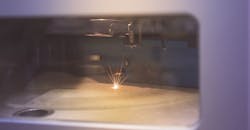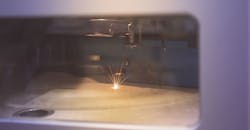11 Myths About Additive Manufacturing, Part 1
Five years ago, Hod Lipson and Melba Kurman gave us Fabricated: The New World of 3D Printing,1 helping to both create and ride a wave of enthusiasm for 3D printing. This enthusiasm, combined with the infusion of U.S. government funding and the expiration of key patents, prompted many to buy a 3D printer for the kids and make stock investments in rising star companies.
Along with their book, Lipson and Kurman gave us the 10 Principles of 3D Printing as a roadmap into the future to explain why 3D printing will disrupt manufacturing and product design. I bought and read the book and enjoyed it. I get that “no one wants to follow a small dream,” but as a process engineer with a background in advanced materials, digital design, and manufacturing, I knew it was not that easy.
Five years later, today, many of the early 3D printer desktop units sit on a shelf while some of those rising star companies are struggling to regain market value after the wild growth boom and bust brought on by all the hype. However, commercial 3D printing and rapid prototyping have continued to evolve, rebranded as Additive Manufacturing (AM).
AM of metal remains on a steady march toward industry adoption, standardization, and certification for critical applications such as in aerospace and medical devices. Some of the myths of the past have been dispelled as adoption by industry brings the technology to light. In other cases, the myths remain as potential users mentally map their experience with 3D home printing into the more formal AM fabrication of critical components in a production environment.
Borrowing heavily from the principals set forth by Lipson and Kurman, my process engineering background, and recent book research2, and with a bit of tongue in cheek, here is my list of 11 Myths About Additive Manufacturing.
Myth 1: Complexity is free.
AM complexity is not free. Much of the cost of component complexity gets pushed upstream to the design process where finding or training skilled personnel to think and design outside the box takes both time and money. Software upgrades and add-ons such as lattice generators and computer aided engineering software may be required.
These images show an injector as it looked immediately after it was removed from the selective laser-melting printer (1) and an injector after inspection and polishing (r). (Credit: NASA/MSFC)
Downstream costs such as post-process finishing operations or inspection of components with complex shapes, internal structures, or varying wall thicknesses can be significantly impacted by complexity. Having said that, one click with a mouse in a CAD program can join multiple piece parts into a single component that may then be 3D printed. Materials engineers at NASA made the one-piece rocket engine injector in just 40 hours (Fig. 1) in a sophisticated 3D printing machine at NASA Marshall Space Flight Center's advanced manufacturing facility.3 It took months to manufacture the same part by welding multiple parts. With AM, value-added complexity is made possible and taken to a new level.
Myth 2: Variety is free.
Parametric design software is great, but understanding the bounding conditions of design variations gets more challenging with greater variety and grows with complexity. However, in AM you are not just changing the part model—you are changing the build model as well, and that may place additional restrictions upon the part orientation, support structures, and post-processing operation such as heat treatment, finish machining, and inspection.
For critical-use components, standardized procedures, and certified parts, re-qualification may be required for any deviation in design, material, or process. Having said that, I am a big fan of the concept of “one size fits one.” I would like nothing better than custom-fit earplugs, sneakers, and bike helmets, but not at 10X the cost where the cost of variety is passed down to me.
Myth 3: No assembly required.
A reduced part count can save on procurement, subcomponent fabrication, tracking, assembly, touch labor, and the bill of materials, as well as shorten supply chains. Demonstration examples made using AM have shown significant savings are possible. However, even though AM machine capacities are increasing, many parts are larger than what current AM systems can produce, requiring two AM piece parts to be fabricated, finished, and welded together.
Fits and finishes remain critical, as do consideration in-service maintenance and repair of components subject to wear, failure, or other service life considerations. A fully “assembled” design may impede powder removal, or access to surfaces and features with critical post-processing or service/repair requirements.
Myth 4: Zero lead time.
I agree that reduced lead-time (not zero) and reduced inventory are highly attractive, as is the potential for local fabrication by multiple service providers. These benefits are often possible for models, prototypes, and non-critical components. However, as you move into critical use and metal components, the change over time between materials and the queue time for specialized post-processing operations may come into play.
Many larger service providers are dedicating machines to specific materials and establishing specialized post-processing operations in-house, such as HIP or EDM (hot isostatic pressing or electrode discharge machining). Transportability of 3D designs between AM metal machines—e.g., getting the same part from a different machine, in a different location—remains an issue when considering the benefit of multiple service providers.
Myth 5: Unlimited design space.
There are a large number of AM materials and processes. All have their limits. While the number of alloys suitable for AM metal processing is growing, the range of materials remains small when compared with conventional processing. Cost and availability of materials are primary design considerations, as are limitations on the part size due to system build volume. AM metal powder can cost twice that of wire feedstock, which can cost twice that of wrought commercial shape metal.
As powder bed processes are currently the most used process for metal 3D printing, companies are starting to produce powders in mass in preparation when 3D printing expands deeper into prototyping, or production. (Credit: Marina_Skoropadskaya/iStock/Getty Images)
Each of the AM processes and machine types have limitations just like any other process. Minimum wall thickness, feature size, and accuracy of surface finish are but a few examples. You may not be constrained to a straight round passage or cooling channel designs, but instead need to use a teardrop- or diamond-shaped passage depending on how the part is oriented relative to the build direction. Having said that, AM can enable the design and fabrication of “impossible components,” those that cannot be made by any other process.
Myth 6: Zero skill manufacturing, removing humans from the loop.
If you have ever manufactured anything you know how many ways there are for things to get screwed up and the corrective action necessary (e.g., responding to a clogged feeding mechanism, diagnosing and replacing a drive motor, troubleshooting a laser or electron beam welding process, etc.). A common myth of AM is there is only one process to learn.
For better or worse, most automated AM processes run without manual intervention. Some have built-in feedback and real time control; some have data acquisition to flag off normal conditions. Many AM machine lock the users out from controlling or even knowing many of the operating parameters due to intellectual property restrictions and do not allow intervention with many of the parameters.
Touch labor expertise is required in machine setup, process monitoring, and post-processing. Support activities such as calibration and maintenance will be just as critical on these machines as with any other fabrication process, and in some cases even more so as you enter the material processing space of lasers and electron beams. You can expect zero skill AM to occur about the same time as autonomous asteroid mining.
Part 2 continues with Myths 7 to 11 about 3D printing bringing compact portable manufacturing, precise digital replication being a one-step process, and more. The true disruption and transformation of manufacturing and construction will occur in space where every aspect of current manufacturing technology will be examined and re-created, starting with a “clean slate” and a new dream.
References
1. Fabricated: The New World of 3D Printing, Hod Lipson, Melba Kurman, ISBN: 978-1-118-35063-8, February 2013.
2. Additive Manufacturing of Metals From Fundamental Technology to Rocket Nozzles, Medical Implants, and Custom Jewelry, John O. Milewski, Springer Series in Materials Science 258, 2017, DOI 10.1007/978-3-319-58205-4.
3. “Rocket Engine Injector Manufactured With 3-D Printing Machine,” July 23, 2013, accessed 12/12/2018.
About the Author
John O. Milewski
John O. Milevsky is a fellow of the American Welding Society. He retired from the Los Alamos National Laboratory, Materials Science Division: Metallurgy after 32 years. He is the recently published author of Additive Manufacturing of Metals, Springer Series in Materials Science 258, 2017.



